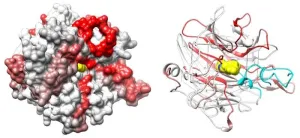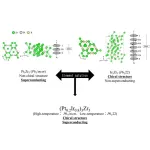City of Hope preclinical study uncovers two proteins’ crucial role in causing cancer cell growth
Scientists identify treatment target that disrupts proteins’ interaction, offering hope for new therapeutic approach
2024-02-05
(Press-News.org)
FINDINGS
Scientists at City of Hope®, one of the largest cancer research and treatment organizations in the United States, have discovered a new cellular mechanism that plays an important role in cancer cells’ ability to cause disease. The study was published in Nature Structural & Molecular Biology today.
A team led by Chun-Wei (David) Chen, Ph.D., an associate professor of systems biology at City of Hope, pinpointed two cell-surface proteins, integrin αV and β5, that partner to spur cancer cell growth. The researchers next identified a region of integrin αV called the β-propeller domain that controls interaction between the two proteins.
Blending laboratory experiments with computer simulations, Chen’s team created a powerful digital application of CRISPR gene-tiling technology to uncover potential cancer medicines that precisely target the β-propeller domain.
After identifying the chemical compound Cpd_AV2 as a strong candidate, the team applied this compound to human cancer cells in the laboratory. Integrin αV and β5 rapidly separated, dissolving communication between the two proteins and causing cellular death, effectively halting growth in cancer cell lines.
Clinically, the researchers found integrin αV overexpression in multiple cancer types, highlighting integrin αV’s lead role in cancer progression. High levels of integrin αV were also associated with a poor prognosis in 3,700 patients with cancers of the breast, pancreas, liver, lung and brain.
SIGNIFICANCE
By expanding opportunities for developing targeted therapies that sever the connection between integrin αV and β5, the City of Hope-led findings suggest a potent new approach for cancer treatment and future medicine discovery studies.
“Our study showcases an innovative application of CRISPR gene-tiling technology, revealing previously undiscovered sites on proteins with the capacity to cause cancer,” said Chen, who is also division director of epigenetic and transcriptional engineering at Beckman Research Institute of City of Hope. “This breakthrough opens new avenues for the advancement of next-generation oncologic therapies, marking a significant milestone in City of Hope’s battle against cancer.”
BACKGROUND
Scientists estimate that up to 1,100 different proteins live on the plasma membrane, or semi-permeable surface of the cancer cell; many of these proteins’ biological functions could influence disease progression and therapeutic response. The region offers a valuable pool of targets for medical intervention because there are plenty of surface receptors and signaling proteins that can be engineered to aid in the delivery of cancer treatments.
Integrin αV and β5 belong to the integrin family, a group of cell-surface receptors that play a central role in regulating cellular interactions, particularly across cell membranes.
FUNDING
The research was partly supported by grants from the American Society of Hematology, Alex’s Lemonade Stand Foundation (18-11849), Stand Up To Cancer & Cancer Research UK (RT617) and the National Institutes of Health’s National Cancer Institute (CA197489, CA233691, CA236626, CA243124, CA278050, CA274649, CA233922, CA255250, CA258778), National Institute of General Medical Sciences (GM117923, CA033572). The National Cancer Institute/Developmental Therapeutics Program provided the compound library.
# # #
About City of Hope
City of Hope's mission is to deliver the cures of tomorrow to the people who need them today. Founded in 1913, City of Hope has grown into one of the largest cancer research and treatment organizations in the U.S. and one of the leading research centers for diabetes and other life-threatening illnesses. City of Hope research has been the basis for numerous breakthrough cancer medicines, as well as human synthetic insulin and monoclonal antibodies. With an independent, National Cancer Institute-designated comprehensive cancer center at its core, City of Hope brings a uniquely integrated model to patients spanning cancer care, research and development, academics and training, and innovation initiatives. City of Hope’s growing national system includes its Los Angeles campus, a network of clinical care locations across Southern California, a new cancer center in Orange County, California, and treatment facilities in Atlanta, Chicago and Phoenix. City of Hope’s affiliated group of organizations includes Translational Genomics Research Institute and AccessHopeTM. For more information about City of Hope, follow us on Facebook, Twitter, YouTube, Instagram and LinkedIn.
END
[Attachments] See images for this press release:

ELSE PRESS RELEASES FROM THIS DATE:
2024-02-05
For years, there has been a long-held belief that acute viral infections like Zika or COVID-19 are directly responsible for neurological damage, but researchers from McMaster University have now discovered that it’s the immune system’s response that is behind it.
The research, published on Feb. 5, 2024 in Nature Communications, was led by Elizabeth Balint, a PhD student at McMaster, and Ali Ashkar, a professor with the Department of Medicine and the Canada Research Chair in Natural Immunity and NK Cell Function.
“We were interested in trying to ...
2024-02-03
Tokyo, Japan – Researchers from Tokyo Metropolitan University have created a new superconductor with a chiral crystalline structure by mixing two materials, one with superconductivity but no chirality, another with chirality but no superconductivity. The new platinum-iridium-zirconium compound transitions to a bulk superconductor below 2.2 K and was observed to have chiral crystalline structure using X-ray diffraction. Their new solid solution approach promises to accelerate the discovery and understanding of ...
2024-02-03
(Millbrook, NY) Cary Institute for Ecosystem Studies is launching a new program to support high school and middle school educators in teaching global change and ecology. Starting in the summer of 2024, nine teachers will spend six weeks at Cary Institute conducting collaborative research in ecosystem science. Follow-up meetings throughout the school year will support the teachers as they develop and implement innovative curricula based on their research experiences.
The program is funded by a three-year award from the National Science Foundation as part of its Research ...
2024-02-03
U.S. Rep. Katie Porter and former Los Angeles Dodger Steve Garvey are deadlocked in the race for second place in the U.S. Senate primary in California, according to a new poll on California politics and policies from USC; California State University, Long Beach; and Cal Poly Pomona.
U.S. Rep. Adam Schiff, a Democrat, leads all candidates with 25% of likely voters, according to the California Elections and Policy Poll. Porter, a Democrat, and Garvey, a Republican, each received support from 15%. Other candidates are in single digits, with Democratic U.S. Rep. ...
2024-02-03
Pancreatic cancer is the No. 3 cause of cancer-related deaths in the United States, and only 12% of patients survive five years after being diagnosed. Severe pancreatic cancer is associated with metastasis, and it is this spread of secondary tumors that usually causes death, but little is known about the molecular mechanisms that drive metastasis.
In a study published Dec. 18 in Advanced Science, researchers from the University of California, Davis showed that abnormal expression of the protein Engrailed-1 (EN1) ...
2024-02-02
Food manufacturers often add preservatives to food products to keep them fresh. A primary purpose of these preservatives is to kill microbes that could break down and otherwise spoil the food. Common additives like sugar, salt, vinegar and alcohol have been used as preservatives for centuries, but modern-day food labels now reveal more unfamiliar ingredients such as sodium benzoate, calcium propionate, and potassium sorbate.
Bacteria produce chemicals called bacteriocins to kill microbial competitors. These chemicals can serve as natural preservatives by killing potentially dangerous pathogens ...
2024-02-02
Huntsman Cancer Institute at the University of Utah (the U) proudly introduces the first and only single-port robot in the Mountain West for head and neck surgical oncology patients. This state-of-the-art technology is a groundbreaking step in the field of oncological surgery, allowing for greater precision and less invasive procedures. Under the visionary leadership of dedicated healthcare professionals, the institute is committed to revolutionizing treatments for cancer patients.
“I am delighted that Huntsman Cancer Institute can now offer cancer patients in the Mountain West access to this innovative and life-changing technology,” says Sachin ...
2024-02-02
Forty-three million Americans lack access to municipal water, and 1 in 10 people globally do not have access to safe drinking water. Rice University’s new WaTER Institute, launched today, aims to address this and other complex water-related challenges.
“Clean water can save more lives than doctors,” said Pedro J. Alvarez , the institute’s director and the George R. Brown Professor of Civil and Environmental Engineering.
The institute’s researchers will also predict and prevent diseases by monitoring wastewater; ...
2024-02-02
(February 2, 2024) The National Association of Epilepsy Centers (NAEC) has developed updated guidelines that outline the comprehensive services and resources epilepsy centers should provide to improve quality of care for people whose epilepsy is not well-controlled.
An Executive Summary of the 2023 Guidelines for Specialized Epilepsy Centers: Report of the National Association of Epilepsy Centers Guideline Panel was published online on February 2, 2024, in Neurology®, the medical journal of the American Academy of Neurology. The complete NAEC guidelines are published as an eAppendix on the journal’s website.
Epilepsy is one of the most ...
2024-02-02
With a $300,000 grant, the Welch Foundation is supporting University of Texas at Arlington research into why some types of Mycobacterium tuberculosis (Mtb), the bacteria that causes the lung disease tuberculosis (TB), do not respond to treatments.
Since its founding in 1954, the Houston-based Welch Foundation has contributed to the advancement of chemistry through research grants, departmental programs, endowed chairs and other special projects in Texas.
“As one of the nation’s largest private funding sources for chemical research, it is our job ...
LAST 30 PRESS RELEASES:
[Press-News.org] City of Hope preclinical study uncovers two proteins’ crucial role in causing cancer cell growth
Scientists identify treatment target that disrupts proteins’ interaction, offering hope for new therapeutic approach






